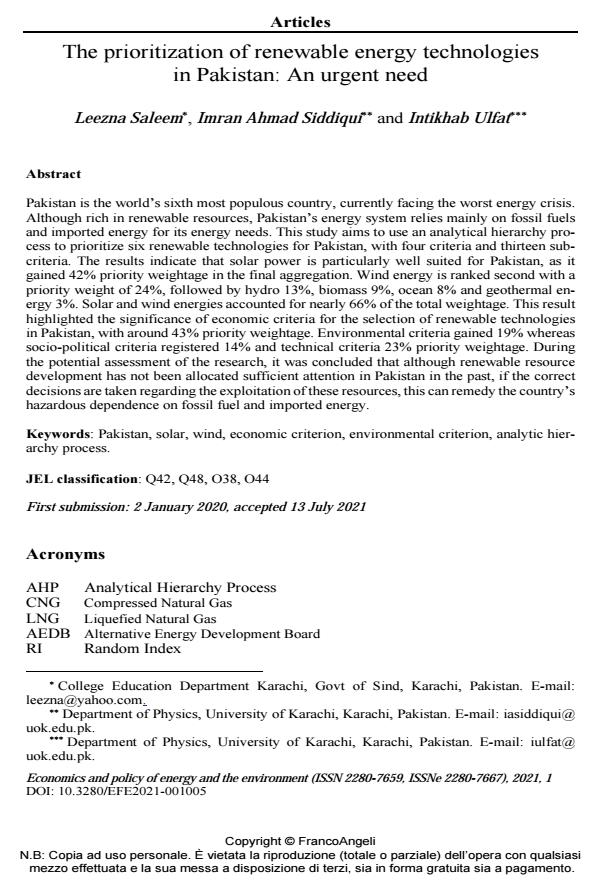The prioritization of renewable energy technologies in Pakistan: An urgent need
Journal title ECONOMICS AND POLICY OF ENERGY AND THE ENVIRONMENT
Author/s Leezna Saleem, Imran Ahmad Siddiqui , Intikhab Ulfat
Publishing Year 2021 Issue 2021/1
Language English Pages 23 P. 81-103 File size 407 KB
DOI 10.3280/EFE2021-001005
DOI is like a bar code for intellectual property: to have more infomation
click here
Below, you can see the article first page
If you want to buy this article in PDF format, you can do it, following the instructions to buy download credits

FrancoAngeli is member of Publishers International Linking Association, Inc (PILA), a not-for-profit association which run the CrossRef service enabling links to and from online scholarly content.
Pakistan is the world’s sixth most populous country, currently facing the worst energy crisis. Although rich in renewable resources, Pakistan’s energy system relies mainly on fossil fuels and imported energy for its energy needs. This study aims to use an analytical hierarchy pro-cess to prioritize six renewable technologies for Pakistan, with four criteria and thirteen subcriteria. The results indicate that solar power is particularly well suited for Pakistan, as it gained 42% priority weightage in the final aggregation. Wind energy is ranked second with a priority weight of 24%, followed by hydro 13%, biomass 9%, ocean 8% and geothermal en-ergy 3%. Solar and wind energies accounted for nearly 66% of the total weightage. This result highlighted the significance of economic criteria for the selection of renewable technologies in Pakistan, with around 43% priority weightage. Environmental criteria gained 19% whereas socio-political criteria registered 14% and technical criteria 23% priority weightage. During the potential assessment of the research, it was concluded that although renewable resource development has not been allocated sufficient attention in Pakistan in the past, if the correct decisions are taken regarding the exploitation of these resources, this can remedy the country’s hazardous dependence on fossil fuel and imported energy.
Keywords: Pakistan, solar, wind, economic criterion, environmental criterion, analytic hierar-chy process.
Jel codes: Q42, Q48, O38, O44
Leezna Saleem, Imran Ahmad Siddiqui , Intikhab Ulfat, The prioritization of renewable energy technologies in Pakistan: An urgent need in "ECONOMICS AND POLICY OF ENERGY AND THE ENVIRONMENT" 1/2021, pp 81-103, DOI: 10.3280/EFE2021-001005